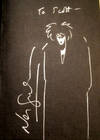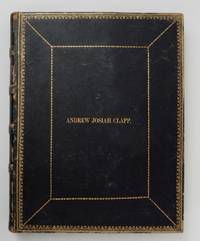![[Photos] First Crossing of Australia's Simpson Desert by Ted Colson, 1936, [together with] photos taken at Colson's Blood Creek Homestead.](https://d3525k1ryd2155.cloudfront.net/h/218/102/1497102218.0.m.jpg)
[Photos] First Crossing of Australia's Simpson Desert by Ted Colson, 1936, [together with] photos taken at Colson's Blood Creek Homestead.: Enlarged from his "little prints" and sent with avuncular messages to his nephew and niece.
by Edmund Albert ‘Ted’ Colson
- Used
- very good
- Condition
- Very Good
- Seller
-
Brisbane, Queensland, Australia
Item Price
SGD 4,054.95
Or just SGD 4,036.93 with a
Bibliophiles Club Membership
Bibliophiles Club Membership
Ask Seller a Question
Payment Methods Accepted
About This Item
Aboriginal and Torres Strait Islander viewers are advised that this collection contains images of people who have died.
Small collection of thirteen photographs relating to the first crossing by a non-indigenous man (with the help of an indigenous man) of Australia's Simpson Desert, together with a few images of his home and its inhabitants in the remote southeast corner of Northern Territory. Includes three photographs of indigenous Australians at Colson's homestead.
Eight 150x160mm images (seven desert crossing images and one Blood Creek homestead image), four smaller images taken at and around Blood Creek (one 10x75mm, two 80x60mm, one 55x55mm) and one 120x80mm colour photo taken at the Colson memorial in Birdsville (circa early 1980s). All but two images have hand-written notes on the verso to Val and Jean, Ted Colson's nephew and niece. One 2cm open tear to top left corner of one of the larger prints; one 2mm open tear to another (border only); rust marks along rhs of a third; light foxing to two of the smaller prints.
Valentine Moyle and his half-sister Jean received these prints in 1936 when Val was 10 years old. His mother Emily (nee Horne) was sister to Ted Colson's wife Alice. Of the desert crossing photographs only two are in sharp focus - the others just a little blurred, as though taken from the back of a moving camel, which they likely were. The desert images appear bleak at first glance, but the avuncular messages are designed to bring them to life in the imagination of the children to whom they were sent. Three of the smaller homestead images are sharply defined, but the one of Jimmy Jimmy "dressed up for visiting" is slightly blurred. The 1980s colour snapshot is of Val as a grown man together with his wife at Colson's memorial opposite the Birdsville Pub.
Edmund Albert 'Ted' Colson was the first non-indigneous man to cross of the Simpson Desert in 1936. His only companion was Eringa Peter of the Antakurinya tribe (pictured in one of the photographs in the distance on a camel). The Simpson Desert, the largest sand desert in the world, had previously defeated Charles Sturt and David Lindsay, but Colson and Peter were able to take advantage of an exceptionally good wet season to make the crossing on camel. Colson set out from his homestead Blood Creek at Mt Etingamba in the S.E. corner of Northern Territory on 26th of May and he and Peter walked into the Birdsville pub, Queensland, sixteen days later, on the 11th of June. Three days after that they headed back again. Colson did not formally publish and so for some years the kudos for first crossing went to Rhodes scholar and Australian explorer Cecil Madigan, who led an expedition across the Simpson desert in 1939.
Only two institutions worldwide (both in South Australia) hold photographs of Colson's crossing of the Simpson: The State Library of South Australia holds Colson's journal, field notes and a collection of 26 expedition photographs. The Royal Geographical Society of South Australia holds 40 photographs, handwritten index sheets and an article on Ted Colson & Peter Haines from the Coober Pedy Times. Each of the four small images taken around the Blood Creek homestead are of the indigenous "help" and are not institutionally held.
The expedition images on offer here are larger than those held by the State Library of South Australia (mostly 50x50 or 50x60mm) or those held by the Royal Geographical Society of South Australia (140x140mm). The larger format provided Ted Colson with ample room for his messages. As Colson explains on one photograph addressed to his nephew Valentine Moyle, "This is enlarged from my little prints". He also provides co-ordinates on the back of one photo and exhorts his then 10-year-old nephew to "look it up" on his map. The text when referring to the the indigenous subjects reflects the paternalistic attitude of White Australia in the 1930s (e.g. "my black boy" when referring to Eringa Peter) but it is possible to read a more complex relationship between white and black through the homestead images which suggest a certain intimacy and affection.
Small collection of thirteen photographs relating to the first crossing by a non-indigenous man (with the help of an indigenous man) of Australia's Simpson Desert, together with a few images of his home and its inhabitants in the remote southeast corner of Northern Territory. Includes three photographs of indigenous Australians at Colson's homestead.
Eight 150x160mm images (seven desert crossing images and one Blood Creek homestead image), four smaller images taken at and around Blood Creek (one 10x75mm, two 80x60mm, one 55x55mm) and one 120x80mm colour photo taken at the Colson memorial in Birdsville (circa early 1980s). All but two images have hand-written notes on the verso to Val and Jean, Ted Colson's nephew and niece. One 2cm open tear to top left corner of one of the larger prints; one 2mm open tear to another (border only); rust marks along rhs of a third; light foxing to two of the smaller prints.
Valentine Moyle and his half-sister Jean received these prints in 1936 when Val was 10 years old. His mother Emily (nee Horne) was sister to Ted Colson's wife Alice. Of the desert crossing photographs only two are in sharp focus - the others just a little blurred, as though taken from the back of a moving camel, which they likely were. The desert images appear bleak at first glance, but the avuncular messages are designed to bring them to life in the imagination of the children to whom they were sent. Three of the smaller homestead images are sharply defined, but the one of Jimmy Jimmy "dressed up for visiting" is slightly blurred. The 1980s colour snapshot is of Val as a grown man together with his wife at Colson's memorial opposite the Birdsville Pub.
Edmund Albert 'Ted' Colson was the first non-indigneous man to cross of the Simpson Desert in 1936. His only companion was Eringa Peter of the Antakurinya tribe (pictured in one of the photographs in the distance on a camel). The Simpson Desert, the largest sand desert in the world, had previously defeated Charles Sturt and David Lindsay, but Colson and Peter were able to take advantage of an exceptionally good wet season to make the crossing on camel. Colson set out from his homestead Blood Creek at Mt Etingamba in the S.E. corner of Northern Territory on 26th of May and he and Peter walked into the Birdsville pub, Queensland, sixteen days later, on the 11th of June. Three days after that they headed back again. Colson did not formally publish and so for some years the kudos for first crossing went to Rhodes scholar and Australian explorer Cecil Madigan, who led an expedition across the Simpson desert in 1939.
Only two institutions worldwide (both in South Australia) hold photographs of Colson's crossing of the Simpson: The State Library of South Australia holds Colson's journal, field notes and a collection of 26 expedition photographs. The Royal Geographical Society of South Australia holds 40 photographs, handwritten index sheets and an article on Ted Colson & Peter Haines from the Coober Pedy Times. Each of the four small images taken around the Blood Creek homestead are of the indigenous "help" and are not institutionally held.
The expedition images on offer here are larger than those held by the State Library of South Australia (mostly 50x50 or 50x60mm) or those held by the Royal Geographical Society of South Australia (140x140mm). The larger format provided Ted Colson with ample room for his messages. As Colson explains on one photograph addressed to his nephew Valentine Moyle, "This is enlarged from my little prints". He also provides co-ordinates on the back of one photo and exhorts his then 10-year-old nephew to "look it up" on his map. The text when referring to the the indigenous subjects reflects the paternalistic attitude of White Australia in the 1930s (e.g. "my black boy" when referring to Eringa Peter) but it is possible to read a more complex relationship between white and black through the homestead images which suggest a certain intimacy and affection.
Reviews
(Log in or Create an Account first!)
Details
- Bookseller
- Archives Fine Books
(AU)
- Bookseller's Inventory #
- 2813
- Title
- [Photos] First Crossing of Australia's Simpson Desert by Ted Colson, 1936, [together with] photos taken at Colson's Blood Creek Homestead.
- Author
- Edmund Albert ‘Ted’ Colson
- Book Condition
- Used - Very Good
- Quantity Available
- 1
- Publisher
- Edmund Albert ‘Ted’ Colson
- Place of Publication
- Blood Creek
- Date Published
- 1936
- Weight
- 0.00 lbs
- Keywords
- Photography; Travel and Exporation; Sand Deserts; Indigenous Australians; letters; children in history
Terms of Sale
Archives Fine Books
30 day return guarantee, with full refund including original shipping costs for up to 30 days after delivery if an item arrives mis-described or damaged.
About the Seller
Archives Fine Books
Biblio member since 2021
Brisbane, Queensland
Ask Seller a Question
About Archives Fine Books
Archives Fine Books has been serving readers, collectors and institutions since 1985. Located in a heritage listed building in the heart of Brisbane's business district, it boasts a large inventory of fine second hand, collectible and rare books.
Also Recommended
-

Save 10% on every purchase!
Join the Bibliophiles’ Club and start saving 10% on every book.
$29.95 / Year
![[Photos] First Crossing of Australia's Simpson Desert by Ted Colson, 1936,](https://d3525k1ryd2155.cloudfront.net/h/218/102/1497102218.0.s.jpg)
![[Photos] First Crossing of Australia's Simpson Desert by Ted Colson, 1936,](https://d3525k1ryd2155.cloudfront.net/h/218/102/1497102218.1.s.jpg)
![[Photos] First Crossing of Australia's Simpson Desert by Ted Colson, 1936,](https://d3525k1ryd2155.cloudfront.net/h/218/102/1497102218.2.s.jpg)
![[Photos] First Crossing of Australia's Simpson Desert by Ted Colson, 1936,](https://d3525k1ryd2155.cloudfront.net/h/218/102/1497102218.8.s.jpg)
![[Photos] First Crossing of Australia's Simpson Desert by Ted Colson, 1936,](https://d3525k1ryd2155.cloudfront.net/h/218/102/1497102218.9.s.jpg)


![[Photographie originale] Neuf tirages photographiques autour de Jean-Michel Folon pour son exposition à la Galerie de France, 1968](https://d3525k1ryd2155.cloudfront.net/h/895/428/536428895.0.m.jpg)
![[Maquette pour un livre de photographies encore inédit à propos des travaux du Grand Louvre :] Photos [prises] de janvier à août 1985.](https://d3525k1ryd2155.cloudfront.net/h/815/644/988644815.0.m.jpg)

![YOSEMITE VALLEY, GENERAL VIEW [53003] with EL CAPITAN, YOSEMITE VALLEY [53013]](https://d3525k1ryd2155.cloudfront.net/h/835/057/1308057835.0.m.0.jpg)
